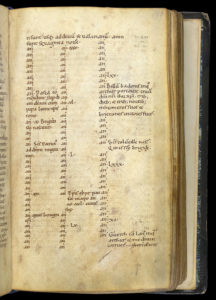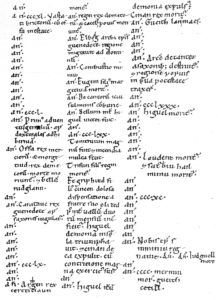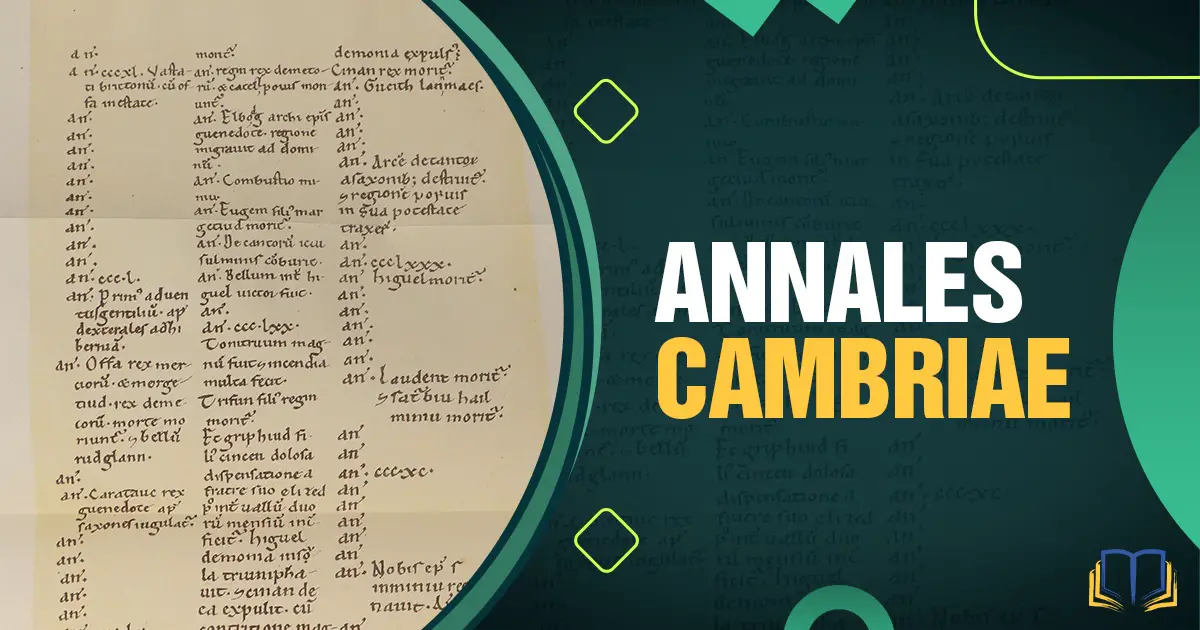
The Annales Cambriae are a complex of Cambro-Latin chronicles compiled or derived from diverse sources at Saint David’s in Dyfed, Wales.
The earliest is a Twelfth-Century AD presumed copy of a mid-Tenth Century AD original; later editions were compiled in the Thirteenth Century AD.
Despite the name, the Annales Cambriae records not only events in Wales, but also events in Ireland, Cornwall, England, Scotland, and sometimes further afield, though the focus of the events recorded especially in the later two-thirds of the text is Wales.
The Principal Versions of Annales Cambriae
Four Manuscripts: A, B, C, and D are all housed in England.
- Manuscript A is in London at the British Library, and is denoted as “MS Harleian 3859, folios 190r-193r”.
- B is also in London at the National Archives as “MS E164/1 (K R Miscellaneous Books, Series I) pp 2–26”.
- C, in London, is at the British Library (as A is) listed as “MS Cotton Domitian A.i, folios 138r-155r”.
- Finally, Manuscript D is in Exeter at the Cathedral Library (in two pieces): “MS. 3514, pp 523–28, the Cronica ante aduentum Domini” and “pp 507–19, the Cronica de Wallia”.
Manuscript A is written in a mid tenth century hand of c AD 1100/1130, is therefore the oldest surviving copy, and is inserted without title into a manuscript (MS) of the middle ages Welsh history, Historia Brittonum, where it is immediately followed by a pedigree for Owain ap Hywel (who died AD 988). Although no explicit chronology is given in the MS, its Welsh annals seem to run from c AD 445 to AD 977, making it likely that the text belongs to the second half of the Tenth Century AD (if indeed the assumed dates are close to correct). The beginning date ascribed to Year 1 of the Annales is arbitrary.
B was written, probably at the Cistercian abbey of Neath, at the end of the Thirteenth Century AD. It is entitled Annales ab orbe condito adusque A. D. mcclxxxvi (AD 1286).
Manuscript C is part of a book written at Saint David’s, and is entitled Annales ab orbe condito adusque A. D. mcclxxxviii (AD 1288); this is also of the late Thirteenth Century AD.
Two of the texts, B and C, begin with a World Chronicle derived from Isidore of Seville’s Origines (Book V, ch 39), through the medium of Bede’s Chronica minora. Manuscript B commences its annals with Julius Caesar’s invasion of Britain “sixty years before the incarnation of the Lord”. After AD 457, B agrees closely with A until A ends.
C commences its annals after the empire of Heraclius (AD 610 to AD 641) at a year corresponding to AD 677. Manuscript C mostly agrees with A until A ends, although it is clear that A was not the common source for B and C, as stated by David N Dumville in 2002. B and C diverge after AD 1203, manuscript C having fewer and briefer Welsh entries.
D is found in a manuscript written at the Cistercian abbey of Whitland in south-west Wales in the later 13th Century AD; the Cronica ante aduentum Domini (which takes its title from its opening words) extends to AD 1285, while the Cronica de Wallia extends from AD 1190 to AD 1266. Manuscript A alone has benefited from a complete diplomatic edition by Egerton Phillimore in his “The Annales Cambriae and Old Welsh Genealogies from Harleian MS 3859” in Y Cymmrodor (1888).
Entries concerning “King Arthur”, and an indirect reference to Merlin

There are two entries in the Annales on King Arthur, one on Medraut (Mordred), and one on Merlin. These entries have been presented in the past as proof of the existence of Arthur and Merlin, although that view is no longer widely held because the Arthurian entries could have been added arbitrarily as late as AD 970, long after the development of the early Arthurian myth.
The entries on Arthur and “Mordred” in the A Text are as follows:
Year 72: (arbitrarily dated as AD 516) “The Battle of Badon, in which Arthur carried the cross of our Lord Jesus Christ on his shoulders for three days and three nights and the Britons were victors.”
Year 93: (arbitrarily dated as AD 537) “The Strife of Camlann in which Arthur and Medraut (assumed to be Mordred) fell and there was death in Britain and in Ireland.”
Concerning Arthur’s cross at the Battle of Badon, it is mirrored by a passage in Nennius where Arthur was said to have borne the image of the Virgin Mary “on his shoulders” during a battle at a castle called Guinnion, as stated by W Lewis Jones.
The words for “shoulder” and “shield” were, however, easily confused in the Old Welsh language: “scuit” meaning “shield” versus “scuid” for “shoulder”.
Geoffrey of Monmouth played upon this dual tradition, describing Arthur bearing “on his shoulders a shield” emblazoned with the Virgin.
Merlin (Old Welsh: Merdin) is not mentioned in the A Text, though there is mention of the battle of Arfderydd, associated with him in medieval Welsh literature:
Year 129: (arbitrarily dated as AD 573) The Battle of Armterid
Texts B and C omit the second half of the year 93 entry. Manuscript B calls Arfderydd “Erderit”; C, “Arderit”. In the B Text, the year 129 entry continues: “between the sons of Elifer and Guendoleu son of Keidau in which battle Guendoleu fell and Merlin went mad”. Both the B and C texts display the influence of Geoffrey of Monmouth’s Historia Regum Britanniae, according to Gough-Cooper in 2012. This is reflected in the Arfderydd entry by the choice of the Latinized form Merlinus, first found in Geoffrey’s Historia, as opposed to the expected Old Welsh form Merdin.
Limited Usefulness
Because the Annales contain no absolute dates of any kind, using it to verify British history or the date of any person, place, or thing appearing in another text is completely ludicrous.
All for which we can hope is a multitude of corroborations in other sources for a particular event, and then use that to assign close to accurate dates for the entries in the Annales Cambriae.
Unfortunately, most “scholars” refuse to do so. Most consider the arbitrarily assigned dates associated with entries in the Annales to be “in stone”. Perhaps future generations will take a more reasonable approach to dating the entries in the Annales Cambriae. One can only hope.
You can read a version of both the A and B versions of Annales Cambriae here.
Bibliography and Further Reading
- Norris Lacy, Geoffrey Ashe, Debra Mancoff – The Arthurian Handbook (Second Edition)
- Alan Lupack – The Oxford Guide to Arthurian Literature and Legend
- Ronan Coghlan – The Illustrated Encyclopaedia of Arthurian Legends
- Anonymous – Lancelot-Grail, the French Vulgate
- Sir Thomas Malory – Le Morte d’Arthur
See also my ever-expanding list of primary and secondary sources.


